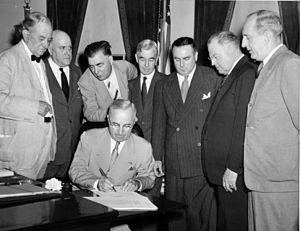
Back Loi sur l'énergie atomique de 1946 French Undang-Undang McMahon ID 1946 Atom Enerjisi Yasası Turkish
 | |
| Long title | An Act For the development and control of atomic energy |
|---|---|
| Enacted by | the 79th United States Congress |
| Citations | |
| Public law | Pub. L. 79–585 |
| Statutes at Large | ch. 724, 60 Stat. 755 |
| Legislative history | |
| |
| Major amendments | |
| Atomic Energy Act of 1954 | |

The Atomic Energy Act of 1946 (McMahon Act) determined how the United States would control and manage the nuclear technology it had jointly developed with its World War II allies, the United Kingdom and Canada. Most significantly, the Act ruled that nuclear weapon development and nuclear power management would be under civilian, rather than military control, and established the United States Atomic Energy Commission for this purpose.
It was sponsored by Senator Brien McMahon, a Democrat from Connecticut, who chaired the United States Senate Special Committee on Atomic Energy, and whose hearings in late 1945 and early 1946 led to the fine tuning and passing of the Act. The Senate passed the Act unanimously through voice vote, and it passed the House of Representatives 265–79. Signed into law by President Harry S. Truman on August 1, 1946, it went into effect on January 1, 1947, and the Atomic Energy Commission assumed responsibility for nuclear energy from the wartime Manhattan Project.
The Act was subsequently amended to promote private development of nuclear energy under the Eisenhower administration's Atoms for Peace program in 1954. In restricting the access to nuclear information to other countries, it created a rift between the United States and its allies, particularly Britain and Canada, which had participated in the Manhattan Project. This resulted in cumbersome command and control arrangements, and in Britain developing its own nuclear weapons. The Act was amended in 1958 to allow the United States to share information with its close allies.